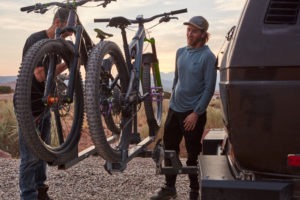It’s a bright, sunny morning. Your water bottles are filled. You’ve had a great night’s sleep. And now it’s time to go crush some miles on your bike for the day! Only problem is as soon as you go to open the garage to pull out the old trusty iron steed, you notice something is wrong: flat tires. What do you do?
Well, the first thing is to pull out your bike pump and simply reinflate them (provided they aren’t punctured and need a new inner tube, but we’ll pretend that you just need to air them up a bit). Thankfully, you got the right one for the job because you read this post! Not all bike pumps are the same, so it’s important to know exactly which pump will work for you. Here are a few ideas on how to choose the right bicycle tire pump for you!
Valve Styles
Before you go out to your local bike shop to panic buy a pump, you need to inspect your bike’s valves. There are two main styles of valves:
- Presta
- Schrader
Despite having the same job (namely being the point of exchange for air going in and out of your tire), they are designed completely differently from one another. Presta valves are characterized by a long, skinny tip, with the pressure release at the top. You can unscrew the pressure release and press down on it to release air from your tire.
Schrader valves on the other hand are the exact same shape as a valve you’d find on any common car. They are short and cylindrical, with the pressure release point surrounded by the valve casing. This makes it more difficult to release air from the tire overall in comparison to the presta valves.
The reason that noting the valve style is important before purchasing a bike pump is that the end that you plug into the bike’s tire valve is specially designed to fit a specific valve. Presta pumps don’t work with Schrader valves and Schrader pumps don’t work with presta valves. Moral of the story here, be sure of the style of valve your bike has before purchasing a pump!
Traditional Hand Pumps
As the old saying goes, “if it ain’t broke, don’t fix it!” Nothing really beats the reliability of a traditional hand pump. The simplicity of the design makes it easy to use and the ease of manufacturing makes them universally available at practically any sporting goods store.
Traditional pumps vary in the amount of volume they are able to output with every stroke. Keep an eye on the size of the pump chamber. The larger the pump chamber, the more air it’s able to push with every stroke, resulting in your tires getting pumped with air quickly.
The biggest con with traditional hand pumps is that the amount of work that you have to put into inflating a completely flat tire can wear you out. It takes a lot of moving up and down with your arms and back to fully inflate a tire. Plus, if you’re trying to install a tubeless system on your bike, traditional hand pumps aren’t fast enough to create the bead you need for a proper seal between the tire and your wheel.
Foot Pumps
If you’ve got a sore back already and you’re not looking to make it any more uncomfortable, give a foot pump a shot. As implied with the name, foot pumps are operated by using your feet rather than your hands to inflate the bike tires. This saves you from having to constantly raise and lower a handle, instead using the strongest muscles in your body (your legs) to help inflate the tire!
The biggest drawback to foot pumps is that the air chambers are pretty small in comparison to hand pumps. This is due to the fact that the whole pump needs to be fairly compact in order to work properly.
Additionally, you’ll find that it’s difficult to find foot pumps that have anything other than a Schrader valve attachment. So, if you have a bike with presta valves, you may want to skip the foot pump.
Electrical Pumps
Hands down, the best pump that you can get is an electrical pump. These are amazing because you literally just need to attach them to a power source, hit the switch, and in seconds you’ll have a fully inflated tire that’s ready to ride! No sweat. No sore backs. No problems.
There are two main styles of electrical pumps you can find:
- Car battery pumps
- Standard house outlet pumps
Each style is a great option. The biggest decision to make really comes down to where you spend more time inflating your tubes. If you spend a lot of time on the road to get to trails to ride, you may want to go with the car battery pump. These are great because they’re compact and easily travel wherever you need them to go.
If you ride closer to home, having an electrical pump that you can just set up in your garage and pull out whenever you need it is a very convenient option. It’s pretty satisfying to be able to hit your tires with a couple of bursts of air after you’ve used the traditional hand pump for years!
Final Thoughts
Remember to always inflate your tires to the manufacture’s recommended rating. Going too low in pressure can run the risk of a pinch flat, which can be a pain to change out and can also ruin your tires. Run your tires too high and you’ll run the risk of blowing them up! Locate the recommended PSI rating on the sidewall of your tire or look up the rating online for your bike’s make and model.
The biggest take away here is that you have a pump on hand that you know you can use. Nothing deflates the anticipation for a fun weekend quite like a flat tire. Having the right tool for the job, no matter where you are, is key to ensuring that those flat tires don’t stop the good times from rolling on. Keep them tires pumped up and we’ll see you out there on the trail!








